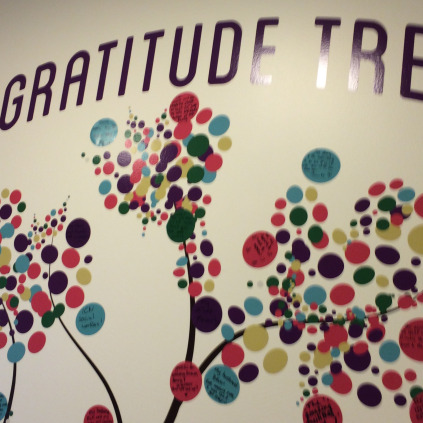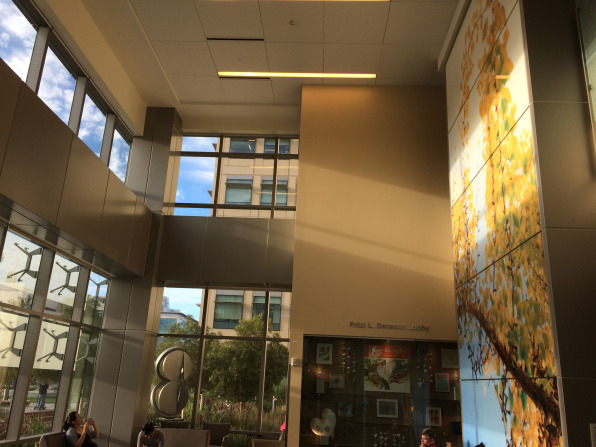UCSF: The Most Beautiful Hospital Complex I've Ever Seen!
The new University of San Francisco healthcare complex: The Women's Hospital is in the foreground, and the Children's Hospital is behind to the right.
Readers of my blogs know that the state of the American healthcare system is a decades-long interest of mine, facilitated by the company, Healing Healthcare Systems, that Susan and I founded 23 years ago. Earlier this year, I attended and blogged about the annual national conference by the Beryl Institute, a cross-disciplinary organization dedicated to improving the Patient Experience. Last week, Susan and I attended a one-day regional conference in San Francisco, hosted by the University of San Francisco Medical Center in their brand-new facility, which just opened this past February. More about the conference in a minute…But first, what’s wrong with American healthcare?
 An infrared projector projects my image on the wall of the Children's Hospital atrium
An infrared projector projects my image on the wall of the Children's Hospital atrium
The significant issues of access to healthcare and the large number of people without health insurance (despite the ACA) were not confronted at the conference. Instead, the focus was on the actions of healthcare workers (administrators, doctors, nurses, technical staff, etc.) that begged for improvement.
Here are two examples that were related to conference attendees:
Case one: A woman discovers a lump in her breast. Because she had recently buried her mother who had died of breast cancer, she was naturally panicked that she might suffer from the same disease. (At this point, it’s worth noting that the woman was an executive at the Disney Corporation, which provided her with full insurance coverage.
Calling a clinic that specialized in mammograms, she was told that the earliest appointment available would be in three weeks. Her anxiety was extreme, faced with the initial delay. Following the eventual mammogram, she learned that her x-rays would be analyzed overseas (India? Korea? South Africa?), taking several more days. A week after the initial mammogram, she received a call from the clinic, saying that the doctor wanted to see her in two weeks (the next available appointment). The scheduler making the call refused to give any details of the mammogram results, citing patient privacy rules. Two weeks later, after sitting for an interminable time in the waiting room, she was met by the doctor, who informed her that the initial x-ray image was fuzzy, and that she needed to have a follow-up mammogram. Waiting for results from the second mammogram (accompanied by even more stress triggered by the uncertainty), the tumor/lump turned out to be benign, posing no danger.
To express her intense frustration at our profit-driven dysfunctional healthcare system, the woman went directly to her Disney office to write a general email blast entitled Never Get a Mammogram at XXXX-Clinic. She sent it to all sixty thousand names on the Disney email list.
A typical unit hallway of the Children's Hospital, complete with art
Case two: A young mother’s twelve year old son was diagnosed with Hodgkin’s Lymphoma, a type of cancer. Her stress was extreme due to that fact that she was trying to manage her full-time job, had a young daughter, and was responsible for the care of her aged mother who lived with her family. Her husband’s job was shaky, and he eventually lost it. She needed to remain at her job in order to keep the insurance coverage for herself, her family, and especially her son. Surviving her encounters with the healthcare system in the course of her son’s treatment led her to write a book about her experiences, yielding her a new career speaking about her experiences to organizations such as the Beryl Institute. Her son is now in his early twenties and is in remission. The difficulties in obtaining treatment over a several year period are too numerous to name them all. But some of the main ones include:
- Unlike in earlier days when the dress code allowed for easy differentiation between physicians, nurses, assistants, and technicians, very few people introduced themselves, such that she didn’t know whom to trust or if anyone was in charge.
- “Silos” are a common occurrence in large organizations, like hospitals. Thus, different medical specialists did not communicate or coordinate with each other.
- The young patient’s preference for one type of treatment (controlled diet and fasting) over another (medication) was not respected.
- A CAT scan delivers the radiation of many x-rays at once. Ultimately, repeated CAT scans (or any) radiation therapy can have negative side effects. Yet, it seemed that whenever her son shifted from one hospital or clinic to another, a new CAT scan would be ordered. Finally, one doctor admitted that they could acquire the information from an x-ray almost as well as from the CAT scans. In other words, a potentially harmful treatment had been needlessly repeated.
Hallway of the Children's Hospital
Around the country every day, many patients and families are having similar experiences during their hospital encounters. This happens in spite of the best intentions held by medical professionals. Such dissatisfactions have given rise to organizations such as the Beryl Institute, organizations that are attempting to improve our disjointed healthcare system from the inside through the efforts of those who see the potential for improvement, not necessarily through spending more money, but rather changing the current fractured culture into one that is more healing.
Visitors write their expressions of gratitude on little stickers which then blossom into the Gratitude Tree.
The Beryl Institute defines the patient experience as: The sum of all interactions, shaped by an organization’s culture, that influence patient perceptions across the continuum of care.
This conference was billed as a “roundtable” session. The approximately one hundred attendees suggested possible topics for discussion, which were then voted on by the group. The most popular six topics were then discussed by small groups in three different sessions, which allowed people to migrate freely among the different discussion groups. The best aspect of the whole conference, for me, was the positive attitude toward improvements at every level of the healthcare system.
At the conclusion of the conference, we had the chance to tour the brand-new hospital, which just opened in February. San Francisco is a rich city, and no expense was spared. It is one of the most beautiful hospitals I’ve ever seen. We only had the opportunity to tour the Children’s Hospital. Our guide related that the administration had done everything they could think of to humanize the environment to support the pediatric patients as well as the attending family members.
The atrium of the Women's Hospital
There is art expressed in different mediums throughout the hospital. There are classes for the young patients who may stay in the hospital for months at a time while undergoing cancer treatment. Thus, school instruction is made available for any age patient who needs it. There are art and music studios. There are rooms for family members to use while staying with their children, which provide kitchens, showers, and free internet access.
The atrium of the Children's Hospital
The high point was seeing the advanced software program on all the television systems. Besides providing the usual entertainment options, such as movies and games, patients and families can choose from extensive food menus available at any time. (The meal trays are delivered by robots(!) which come up the elevators and then roll to the rooms which have ordered food. A staff member is necessary to take the food trays from the robot transport into the patient’s room.
And finally, our C.A.R.E. Channel has been in the University of San Francisco’s various medical centers for several years. We were very interested to see how our channel is integrated into the advanced patient software program. We were pleased to see that there is a dedicated C.A.R.E. Channel button right in the main menu. Every patient room has a new sixty-five inch LCD high-definition television. Our channel looked fantastic. We were so pleased and proud for our programming to be present as an integral part of patient care in this fantastic progressive hospital.
The view of the San Francisco Bay from the rooftop garden of the Children's Hospital







2 Comments on UCSF: The Most Beautiful Hospital Complex I've Ever Seen!
Join the Conversation